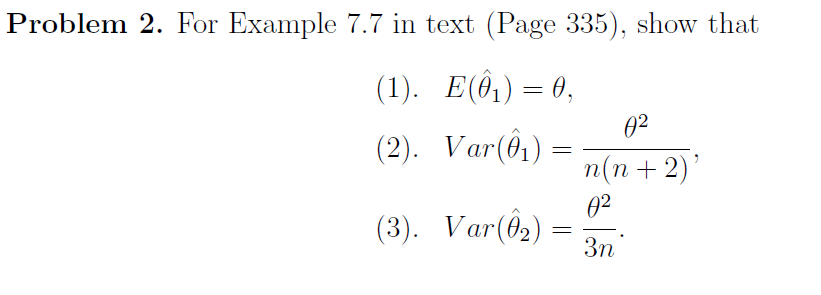thank you

Extracted text: Problem 2. For Example 7.7 in text (Page 335), show that (1). E(Ô,)= 0, 02 (2). Var(ê) п(п + 2) 02 (3). Var(@2) 3n
![We argued in Example 7.5 that when X1, ..., X, is a random sample from a uniform<br>distribution on [0, 0], the estimator<br>Example 7.7<br>п+1<br>max(X1, ..., X„)<br>n<br>is unbiased for 0 (we previously denoted this estimator by 04). This is not the only<br>unbiased estimator of 0. The expected value of a uniformly distributed rv is just the<br>midpoint of the interval of positive density, so E(X;) = 0/2. This implies that<br>E(X) = 0/2, from which E(2X) = 0. That is, the estimator Ô2<br>If X is uniformly distributed on the interval [A, B], then V(X) = o<br>(Exercise 23 in Chapter 4). Thus, in our situation, V(X;) = 0²/12, V(X)<br>o2/n = 0 /(12n), and V(Ô2) = V(2X) = 4V(X) = 0² /(3n). The results of Exercise<br>50 can be used to show that V(01)= 0²/[n(n+2)]. The estimator 0, has smaller<br>variance than does 02 if 3n < n(n + 2)–that is, if 0 < n² – n = n(n – 1). As long as<br>n > 1, V(01) < V(02), so 01 is a better estimator than 02. More advanced methods<br>can be used to show that 0, is the MVUE of 0-every other unbiased estimator of 0<br>has variance that exceeds 0 /[n(n + 2)].<br>= 2X is unbiased for 0.<br>(B -A)/12<br>](https://s3.us-east-1.amazonaws.com/storage.unifolks.com/qimg-008/008_otztyp0-hs51iq4l.png)
Extracted text: We argued in Example 7.5 that when X1, ..., X, is a random sample from a uniform distribution on [0, 0], the estimator Example 7.7 п+1 max(X1, ..., X„) n is unbiased for 0 (we previously denoted this estimator by 04). This is not the only unbiased estimator of 0. The expected value of a uniformly distributed rv is just the midpoint of the interval of positive density, so E(X;) = 0/2. This implies that E(X) = 0/2, from which E(2X) = 0. That is, the estimator Ô2 If X is uniformly distributed on the interval [A, B], then V(X) = o (Exercise 23 in Chapter 4). Thus, in our situation, V(X;) = 0²/12, V(X) o2/n = 0 /(12n), and V(Ô2) = V(2X) = 4V(X) = 0² /(3n). The results of Exercise 50 can be used to show that V(01)= 0²/[n(n+2)]. The estimator 0, has smaller variance than does 02 if 3n < n(n="" +="" 2)–that="" is,="" if="" 0="">< n²="" –="" n="n(n" –="" 1).="" as="" long="" as="" n=""> 1, V(01) < v(02),="" so="" 01="" is="" a="" better="" estimator="" than="" 02.="" more="" advanced="" methods="" can="" be="" used="" to="" show="" that="" 0,="" is="" the="" mvue="" of="" 0-every="" other="" unbiased="" estimator="" of="" 0="" has="" variance="" that="" exceeds="" 0="" [n(n="" +="" 2)].="2X" is="" unbiased="" for="" 0.="" (b="">